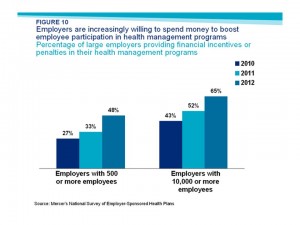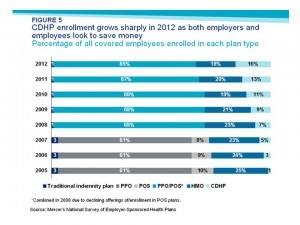Health benefit costs grew a relatively low 4.1% in 2012 (5.4% for large employers), largely due to companies moving workers into lower-cost consumer-directed health plans. Last year, benefit costs grew at an annual rate of 6.1%, representing about a 30% fall in year-on-year cost growth for companies. And, coverage is up to 59% of employees having ticked down to 55% for the past couple of years.
Employers expect about a 5% increase for 2013.
Mercer’s National Survey of Employer-Sponsored Health Plans analysis finds that U.S. employers are looking toward 2014, when they’ll be covering more uninsured workers, and using this advance time to lower costs and get systems into place to promote worker health. Thus, more companies are adopting wellness and health promotion programs to help stem costs and bolster productivity for workers. Very few firms expect to terminate health benefits in the next five

years.
What’s most notable is the growth of consumer-directed health plans: high-deductible, account-based programs, now covering 16% of all covered employees in 2012. CDHPs are offered by 22% of all employers– 59% of “jumbo” employers with 20,000 employees or more.
Mercer’s survey was conducted in late summer 2012 among 2,809 employers represented over 104 million workers.
Health Populi’s Hot Points: For employers, it’s welcome news that health cost increases are moderating. For workers covered by employer-based health insurance, it’s no surprise that they’re bearing greater costs for health care in the form of higher deductibles, greater out-of-pockets, and more cost-sharing in coinsurance for specialty drugs. This is the more severe “stick” component of more skin-in-the-game that is the construct of so-called consumer-driven health care.
On the “carrot” side of the ledger, though, consumers should take advantage of the growing health management programs employers are investing in to self-manage health and wellness, and target chronic conditions like diabetes, asthma, and heart disease. These are hard-dollar investments that companies are making in worker wellness to, yes, help stem cost increases year-on-year. But for the worker herself, these programs are an opportunity to take advantage of. Like a 401(k) program that bolsters savings with a tax benefit, so worker wellness programs are a kind of “freebie” for workers to co-invest in personal health. Consumers fortunate enough to be offered such programs should view them as a valuable employee benefit that not only helps their employer, but benefits themselves and their families. In this case, “benefit” has multiple meanings — and most especially, a personal one.





 I am so grateful to Tom Lawry for asking me to pen the foreword for his book, Health Care Nation,
I am so grateful to Tom Lawry for asking me to pen the foreword for his book, Health Care Nation,  I love sharing perspectives on what's shaping the future of health care, and appreciate the opportunity to be collaborating once again with Duke Corporate Education and a global client on 6th May. We'll be addressing some key pillars to consider in scenario planning such as growing consumerism in health care, technology (from AI to telehealth), climate change, and trust -- the key enabler for health engagement or dis-engagement and mis-information. I'm grateful to be affiliated with the corporate education provider
I love sharing perspectives on what's shaping the future of health care, and appreciate the opportunity to be collaborating once again with Duke Corporate Education and a global client on 6th May. We'll be addressing some key pillars to consider in scenario planning such as growing consumerism in health care, technology (from AI to telehealth), climate change, and trust -- the key enabler for health engagement or dis-engagement and mis-information. I'm grateful to be affiliated with the corporate education provider  Thank you FeedSpot for
Thank you FeedSpot for